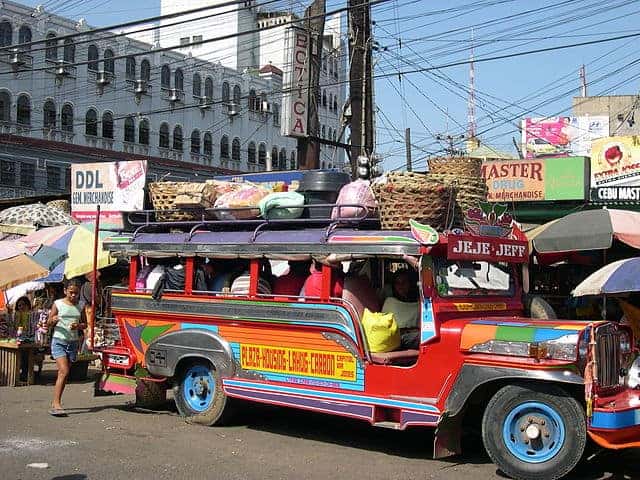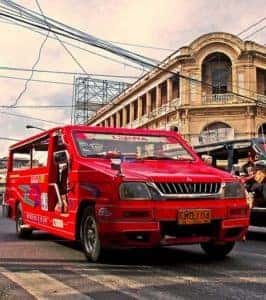What is a Jeepney?
Pickup trucks and muscle cars are symbols of American automotive history. The Volkswagen is a symbol for Germany and the mini a symbol for Great Britain.
The Jeepney is the symbol for the Philippines.
Just like you’ll see yellow taxis crawling all over the streets of New York, if you travel to the Philippines, you’ll see Jeepneys for miles.
You’ll like never find a Jeepney at a local Jeep dealership — unless you find a rare, private model — but the Jeepney represents an important part of Jeep history and it shares a common bond with many of the models you’ll be able to buy today.
A Military Beginning
Like all other Jeep models, the Jeepney has its roots in World War II.
The U.S. military put out a call for automakers to design a reconnaissance vehicle that forces would use on the field. The result was what would become the current Jeep.
During World War II, the U.S. military stationed itself in the Philippines to strategize on the Japanese. When the war was over, the military found itself with a surplus of Jeeps.
The U.S. military either gave away the Jeeps or sold them at a discount. Those Jeeps were then modified to become the original Jeepneys, which were used to re-establish public transportation that was destroyed by the war.
Transformation to Public Transport
The original Jeeps used in World War II were smaller than today’s Jeepneys, and they were designed as passenger vehicles without roofs. They were remodeled extensively to carry multiple passengers and form the backbone of the public transportation system in the Philippines.
Of course, roofs were added, as were long, parallel benches in the back for passengers. The benches faced each other, and passengers were squeezed in with their knees touching.
Perhaps the most notable of the design changes between the original Jeeps and the Jeepneys were the bright colors and graphics all over the exterior, as well as the chrome-plated ornaments on the hood. The colorful Jeepney rivals the Volkswagen buses that rolled into Woodstock in the 1960s.
Over time, the Jeepney received many other design updates to accommodate more passengers and create a slightly more comfortable ride. The Jeepney still offers a packed ride, but its body is slightly longer and wider. It fits more passengers, even if it doesn’t offer them more leg room.
New Manufacturers
Jeep never actually made the Jeepney. It made the model that was eventually turned into the Jeepney after the modifications, but it never mass-produced a Jeepney.
The company Sarao started manufacturing the Jeepney in 1953. Francisco Motors rivaled it for a time, but Sarao-manufactured Jeepneys outnumbered all other models.
Sarao is still producing Jeepneys on a small scale, but Francisco Motors has stopped production. Other manufacturers producing Jeepneys include Mega, Morales Motors, Tandenrich Motors, Celestial Motors, Armak Motors, Malagueña, LGS Motors, Hebron Motors, PBJ Motors and MD Juan.
Many of the Jeepney manufacturers are what is known as “backyard builders.” They make only one to five Jeepneys per month using die-stamped pieces and salvaged engines. Large-volume manufacturers can either create public-utility Jeepneys or can supply parts alongside complete vehicles.
Outside of Manila, there are other Jeepney manufacturers who are creating different designs. In Cebu, Jeepneys are put together from surplus Japanese trucks such as Suzuki and Isuzu. These Jeepneys have a flatter nose, advanced technology like high-powered sound systems, and more capacity for passengers and cargo.
Iloilo City produces Jeepneys known as passad, which have a sedan chassis with a longer body. In Davao City, Jeepneys are known as uso-uso and they feature a more modern design with a lower platform, updated grille and chrome wheels.
Jeepney as Public Transportation
Shortly after their introduction, Jeepneys became regulated by the Filipino government for use as public transportation.
Drivers must have a special license to operate a Jeepney, and they have offer regular routes and reasonable fares. Jeepneys are like smaller versions of buses. They have a regular route, but passengers can signal that they want to get off at any point on the route, rather than at set stops. A sign on the side of the Jeepney shows the start and end point for the route.
Most of the time, Jeepneys don’t even stop. They just slow down enough to let passengers jump on or off. Entry is through the back, which is left open without a door. There are few privately owned Jeepneys, but those that are on the road are marked by a door at the rear with a sign indicating their private status.
To board a Jeepney, passengers must wait at the pickup stand or must flag one down like a taxi. To get off a Jeepney, most riders call out “Para,” which means “stop.” In the past, it was common practice for passengers to knock on the ceiling or a railing to request a stop, or to tap a coin against metal. However, many Jeepneys now have signs inside that tell passengers how rude it is to use these methods, claiming knocking is for doors and whistling is for dogs.
Jeepneys are quite crowded, not only with passengers but also with livestock and wares. It’s not uncommon to see a pig or a chicken on a Jeepney. When the ride is overloaded, some passengers may stand on the bumper and hang off the back or even ride on the roof.
Typically, women and the elderly are offered seats if there is standing-room only — just like what is supposed to happen on public buses and subways. Excess talking and shoving are both considered rude when riding a Jeepney because of the close quarters.
Though the government now regulates the operation of Jeepneys, illegal operators still exist, and there are many safety issues with the vehicles. The color of the vehicle plates indicate if a Jeepney is licensed or not.
Future of the Jeepney
The Jeepney is such an integral part of Filipino culture that it certainly has a strong future in the country. In fact, the Jeepney is so linked with the Philipines that there is a restaurant in New York City called Jeepney that serves Filipino food.
Jeepneys have evolved significantly over the years to grow in size and improve their features, and the future of Jeepney is expected to include more upgrades.
In addition to increasing the size and improving the engine, Jeepney manufacturers are now planning a more eco-friendly model that includes an electric engine with lower emissions.
It is unclear if Jeepneys would ever be made for widespread sale so you could find it at a local Jeep dealership, but the history of the Jeepney is a unique footnote in Jeep history that informs the evolution of the line. Even if you are never able to buy a Jeepney, you can feel like you take a little bit of the Jeepney with you whenever you drive a Jeep Wrangler or other Jeep model, which share the same design history.
You can always visit the Philippines to take a ride on a Jeepney then visit your local Jeep dealership to find your next vehicle for everyday driving.













